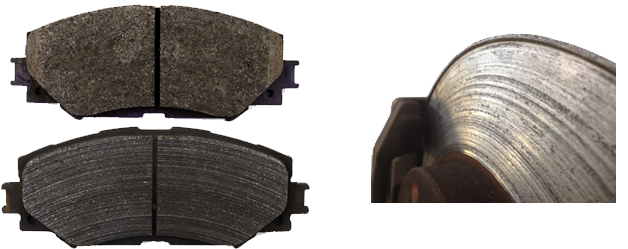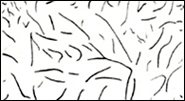Rotor strike dan proses melepuh
Ia adalah apabila bahan pemutar "menyerang" permukaan pad brek.
Ciri-ciri kerosakan:
 Dalam proses brek biasa, bahan pad brek bergerak ke permukaan rotor untuk mencipta
lapisan brek yang mesra.
Kekerasan adalah harta fizikal yang paling penting (tetapi bukan satu-satunya) yang
bertanggungjawab untuk proses ini.
(Lihat di bawah kualiti bahan Rotor)
Pad Brek Seramik tidak melelas lebih terdedah kepada kekerasan rendah berbanding
formulasi pad brek logam yang agak lembut. Kekerasan galas seramik mesti kekal melebihi
220 pada skala Brinell. Sebagai contoh, kebanyakan rotor OEM dihasilkan dengan kekerasan
melebihi 240 oleh Brinell. Tetapi malangnya, rotor selepas pasaran mempunyai kekerasan
yang jauh di bawah itu.
Panas terik memanaskan matriks bahan geseran kepada 600-700°C, membolehkan pengkarbonan
berlaku pada permukaan pad brek 0.5 hingga 1.5mm pertama.
Ini adalah pencegahan yang baik terhadap serangan rotor untuk rotor selepas pasaran yang
biasanya dihasilkan dengan Kekerasan 170-200.
Selain itu, ia mengurangkan masa masuk tempat tidur untuk menggantikan pad brek ke tahap
minimum dengan lapisan pengkarbonan lembut sedia untuk digunakan.
Berikut ialah formula untuk penampilan yang sama dengan dan tanpa pembakaran.
Dalam proses brek biasa, bahan pad brek bergerak ke permukaan rotor untuk mencipta
lapisan brek yang mesra.
Kekerasan adalah harta fizikal yang paling penting (tetapi bukan satu-satunya) yang
bertanggungjawab untuk proses ini.
(Lihat di bawah kualiti bahan Rotor)
Pad Brek Seramik tidak melelas lebih terdedah kepada kekerasan rendah berbanding
formulasi pad brek logam yang agak lembut. Kekerasan galas seramik mesti kekal melebihi
220 pada skala Brinell. Sebagai contoh, kebanyakan rotor OEM dihasilkan dengan kekerasan
melebihi 240 oleh Brinell. Tetapi malangnya, rotor selepas pasaran mempunyai kekerasan
yang jauh di bawah itu.
Panas terik memanaskan matriks bahan geseran kepada 600-700°C, membolehkan pengkarbonan
berlaku pada permukaan pad brek 0.5 hingga 1.5mm pertama.
Ini adalah pencegahan yang baik terhadap serangan rotor untuk rotor selepas pasaran yang
biasanya dihasilkan dengan Kekerasan 170-200.
Selain itu, ia mengurangkan masa masuk tempat tidur untuk menggantikan pad brek ke tahap
minimum dengan lapisan pengkarbonan lembut sedia untuk digunakan.
Berikut ialah formula untuk penampilan yang sama dengan dan tanpa pembakaran.
 Kualiti bahan pemutar.
Rotor biasanya diperbuat daripada besi kelabu kerana pengendalian haba yang unggul dan
ciri-ciri redaman (penyerapan getaran).
Kualitinya bergantung kepada gabungan sifat fizikal, komposisi kimia dan struktur
mikro.
Ciri-ciri fizikal
Ditentukan oleh standard SAE J431 G3000 untuk pemutar dan dram brek automotif
termasuk:
1. Kekerasan oleh Brinell: 187-241,
2. Kekuatan tegangan minimum 30,000 psi
Komposisi kimia besi kelabu G3000:
Karbon 3.10%-3.40%,
Silikon 1.90%-2.30%,
Manganese 0.60%-0.90%,
Sulfur Max 0.15%,
Phosphorus Max 0.15%,
Jumlah Karbon equivalent of 3.9%-4.15%
Struktur mikro yang lebih rendah.
Kualiti bahan pemutar.
Rotor biasanya diperbuat daripada besi kelabu kerana pengendalian haba yang unggul dan
ciri-ciri redaman (penyerapan getaran).
Kualitinya bergantung kepada gabungan sifat fizikal, komposisi kimia dan struktur
mikro.
Ciri-ciri fizikal
Ditentukan oleh standard SAE J431 G3000 untuk pemutar dan dram brek automotif
termasuk:
1. Kekerasan oleh Brinell: 187-241,
2. Kekuatan tegangan minimum 30,000 psi
Komposisi kimia besi kelabu G3000:
Karbon 3.10%-3.40%,
Silikon 1.90%-2.30%,
Manganese 0.60%-0.90%,
Sulfur Max 0.15%,
Phosphorus Max 0.15%,
Jumlah Karbon equivalent of 3.9%-4.15%
Struktur mikro yang lebih rendah.
 Bentuk grafit serpihan (pembesaran 100X)
Bentuk grafit serpihan (pembesaran 100X)


Struktur mikro mutiara = taburan grafit dan struktur matriks besi tuang.
Matriks ini harus dikuasai oleh pearlit, dengan kandungan ferit tidak lebih daripada
5% dan simentit kurang daripada 1%.
Matriks ini harus dikuasai oleh pearlit, dengan kandungan ferit tidak lebih daripada
5% dan simentit kurang daripada 1%.
 Bentuk grafit serpihan (pembesaran 100X)
Bentuk grafit serpihan (pembesaran 100X)

